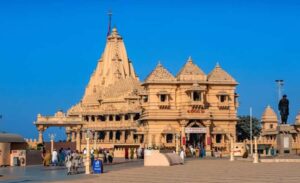Facts About The Shri Ram Mandir in Ayodhya
The Sri Ram Mandir in Ayodhya is a monumental endeavor that holds profound significance for millions of devotees worldwide. As the sacred city undergoes the creation of this grand temple dedicated to Lord Shri Ram, a plethora of facts and intricacies surround its inception, design, and cultural implications. In exploring the Sri Ram Mandir Ayodhya, we unravel a comprehensive tapestry woven with historical, architectural, and spiritual threads.

Historical and Cultural Significance
The construction of the Sri Ram Mandir in Ayodhya is a momentous undertaking deeply rooted in historical reverence. Ayodhya, known as the Ram Janambhoomi, holds profound significance as the believed birthplace of Lord Shri Ram. The temple’s inception is intricately tied to the rich tapestry of the Ramayana, adding layers of cultural and spiritual importance to this monumental project.
Architectural Marvel
Envisioned as a marvel of architecture, the Sri Ram Mandir is not merely a place of worship but a testament to design excellence. The Sompura family, renowned for their architectural prowess, leads the construction, ensuring a seamless blend of tradition and modernity. The exclusive use of stones, adherence to ancient Shastras, and the integration of international elements showcase a meticulous approach to crafting a timeless structure.
Foundation with Holy Soil from 2587 Regions
The temple’s foundation, comprising holy soil from 2587 regions, symbolizes a unifying force across diverse landscapes. From Jhansi to Golden Temple, this sacred foundation weaves a spiritual connection, emphasizing the unity amidst diversity. Each particle contributes to the sanctity of the temple, fostering a sense of oneness transcending geographical boundaries.
Sacred Inscribed Bricks
An eloquent nod to history, the bricks used in constructing the temple are inscribed with the sacred words ‘Shri Ram.’ This echoes an ancient practice reminiscent of the construction of Ram Setu, infusing the structure with spiritual resonance. The modern iteration of these bricks promises enhanced strength and durability, linking the present construction to age-old traditions.
Cultural Integration
The Sri Ram Mandir seamlessly integrates cultural elements from various corners of the globe. Soil from Thailand, incorporated into the consecration ceremony, exemplifies international spiritual camaraderie, transcending geographical confines. This integration underlines the universal resonance of Lord Ram’s legacy and his cultural significance beyond national borders.
Narrative Unfolded in Stone
The architectural narrative of the temple unfolds across three floors, covering a vast area of 2.7 acres. The ground floor intricately depicts the life of Lord Ram, encompassing his birth and childhood. Ascending to the first floor, visitors are immersed in the grandeur of Lord Ram’s Darbaar, a visual spectacle crafted with Bansi Paharpur, a pink sandstone sourced from Rajasthan’s Bharatpur.
Dimensional Magnificence
The Sri Ram Mandir stands as the largest temple in India, boasting impressive dimensions. With a length of 360 feet, a width of 235 feet, and a total height, including the peak, reaching 161 feet, the temple stands as a majestic testament to architectural grandeur. With three floors and a total of 12 gates, it becomes a monumental symbol of devotion and artistic finesse.
Spiritual Confluence
The consecration ceremony on August 5th was enriched by the presence of holy water from 150 rivers across India. This sacred blend, sourced from various rivers and locations, symbolizes a spiritual union, creating a unique concoction that mirrors the diversity of India’s sacred waters. The integration of these waters embodies a spiritual confluence, echoing the pluralistic ethos of the nation.
Time Capsule for Posterity
Adding a visionary touch to the temple’s construction is the placement of a time capsule, buried 2000 feet below the ground beneath the temple. This capsule, equipped with a copper plate inscribed with relevant information about the temple, Lord Ram, and Ayodhya, serves as a bridge connecting the present to the future, ensuring the preservation of the temple’s identity for posterity.
Unveiling Mythological Layers
Archaeological surveys suggest intriguing layers to the history of the site. Some surveys propose that the Babri Mosque was built upon a pre-existing structure, possibly from Lord Ram’s era. However, debates continue, with historical narratives and archaeological findings adding layers of mystery to the temple’s mythological and historical significance.
Revamping Temple Town
The construction of the Ram Mandir has not only become a focal point of spiritual devotion but has also triggered a broader initiative to revamp the entire town of Ayodhya. With development projects worth 500 Crores, including new infrastructure and amenities, Prime Minister Modi aims to transform Ayodhya into a thriving cultural and spiritual hub.
Anticipation for the Future
According to the supervising agency, the Shri Ram Janambhoomi Teerth Kshetra Trust, the temple’s construction has reached 90% completion. Anticipated to open its doors to devotees by January 2024, the Ayodhya Ram Mandir stands not just as a testament to the past but as a beacon guiding the spiritual and cultural aspirations of future generations.
In conclusion, the Sri Ram Mandir Ayodhya emerges as a masterpiece that goes beyond architectural brilliance – it encapsulates the spirit of a cultural and spiritual resurgence, echoing the timeless values embodied by Lord Shri Ram.
- Also Read: Best Time to Visit Ram Mandir, Ayodhya





